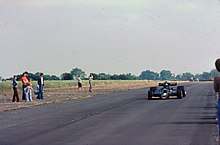Lotus 78
Having studied the de Havilland Mosquito fighter bomber, he had paid close attention to its wing mounted radiators, and the hot air outlets that were designed to induce lift.
Careful examination of Bernoulli's principle of fluid dynamics confirmed his thoughts on the effects of an upturned aeroplane wing profile fitted to a car, and he finally handed the document to his head of engineering, Tony Rudd.
[3] Rudd appointed a team to work on the project: chief designer Ralph Bellamy, vehicle engineer Martin Ogilvie and aerodynamicist Peter Wright.
Rudd and Wright had previously worked for BRM, and before joining Lotus in 1970 had done a design study into the possibility of an inverted wing profile fitted to one of their cars.
Wright then set about experimenting with F1 car body shapes using a wind tunnel and a rolling road, when by happy accident he began to get remarkable results in one of the models.
Wright experimented with pieces of cardboard attached to the side of the model car body, and the level of perceived downforce produced was phenomenal.
[6] The 78 was loosely based on the Lotus 72, sharing the same basic wedge shape and internal layout, but featuring detailed aerodynamic improvements, better weight distribution and a longer wheelbase.
This ground effect had the great advantage of being a low drag solution unlike conventional wings, meaning that the increased cornering ability was not compromised by a decrease in straight-line speed.
Unfortunately after first tests were done, the low pressure area under the car was found to be too far forward, requiring a very large rear wing to be designed resulting in a lot of drag at high speeds.
Eventually a smaller wing was designed in time for the Italian Grand Prix (see above picture), which cut the drag factor significantly, and allowed Andretti to take a popular 'home' victory.
[9] It was obvious that the Lotus 78 had some special feature, as proved by Andretti and Gunnar Nilsson winning the race in Belgium: When the car worked well, it was almost uncatchable.
The Swede was caught up in a massive start line accident, which resulted in his car ramming the barriers nose-first, completely destroying the front end of the vehicle.



